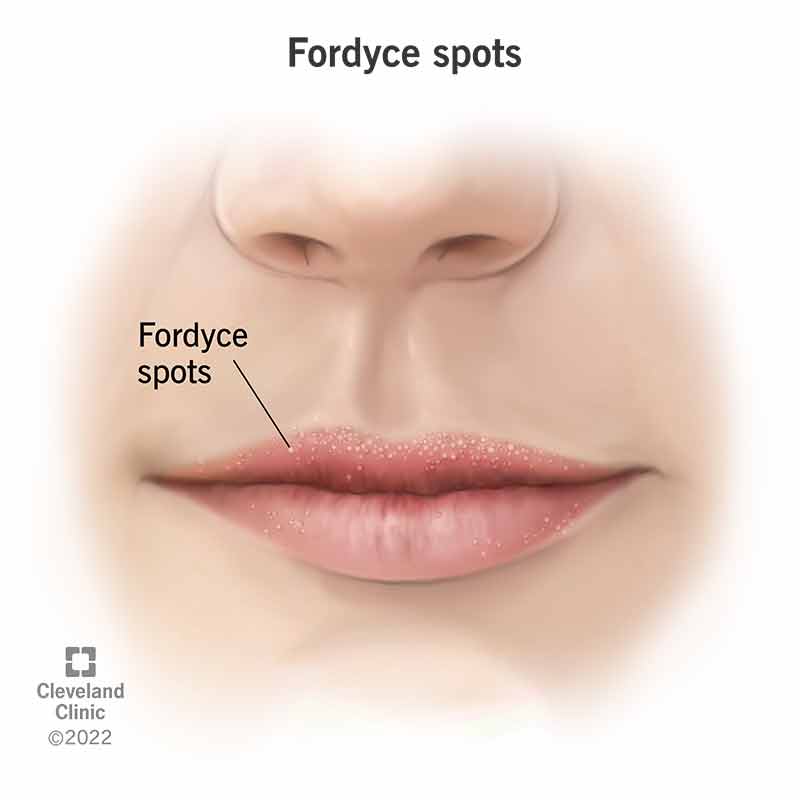Fordyce spots are a common skin condition where oil glands appear larger. They become more noticeable during or after puberty. They often appear on and around your lips and sometimes on your penis and vagina. They’re a natural part of your skin, but treatments can shrink or remove them.
Advertisement
Cleveland Clinic is a non-profit academic medical center. Advertising on our site helps support our mission. We do not endorse non-Cleveland Clinic products or services. Policy

Fordyce spots (Fordyce granules) are enlarged, slightly raised sebaceous (oil) glands that appear in hairless areas of your skin. They commonly appear around the edges of your lips (vermillion border) and inside of your cheeks. They sometimes appear around your genital area. Fordyce spots are benign (not cancerous).
Advertisement
Cleveland Clinic is a non-profit academic medical center. Advertising on our site helps support our mission. We do not endorse non-Cleveland Clinic products or services. Policy
American dermatologist Dr. John Addison Fordyce first described Fordyce spots in 1896.
You may be alarmed to notice Fordyce spots around your mouth or genital area, including your:
But Fordyce spots aren’t sexually transmitted diseases or infections (STDs or STIs). The appearance of Fordyce spots in these areas is normal, and they aren’t contagious.
Genital herpes is an STI caused by the herpes simplex virus (HSV). People with genital herpes develop painful blisters on their genitals. They can spread herpes through vaginal, oral and anal sex. They can also spread herpes through kissing or skin-to-skin contact if they have open sores. Herpes simplex virus type 1 (HSV-1) can cause cold sores to form on the lips, gums, tongue and inside of your mouth.
Fordyce spots aren’t STDs or STIs, and they aren’t contagious.
Genital warts are an STD caused by the human papillomavirus (HPV). People with genital warts develop small bumps or growths in and around their genitals and rectum. Genital warts and HPV are both highly contagious.
As genital warts initially develop, they may look like Fordyce spots. If you notice the sudden appearance of small bumps on your genitals, it’s a good idea to see a healthcare provider for a proper diagnosis.
Advertisement
Fordyce spots affect everyone. They typically don’t appear during early childhood. They become more noticeable during puberty and adulthood as some of your hormones increase. Males develop Fordyce spots about twice as often as females.
Fordyce spots are very common — 70% to 80% of adults have Fordyce spots.
Fordyce spots look like white, yellow, pale red or skin-colored bumps. They may appear as a singular spot or small groups of spots, but they can also appear in clusters of 50 spots or more. They’re easier to see if you stretch out the surrounding skin.
They’re small — typically 1 to 3 millimeters (mm) in diameter, which is about the size of the tip of a sharp pencil (1 mm) or a sesame seed (3 mm).
Fordyce spots don’t cause any pain, but there have been some reports of Fordyce spots on the penis becoming itchy or inflamed during sex.
Some researchers suggest that you may have Fordyce spots at birth. They become more obvious during puberty and into adulthood as your hormones start changing.
Fordyce spots aren’t contagious, and you can’t get Fordyce spots through skin-to-skin contact. You don’t need to take extra steps to protect your partner while kissing or during sex if you have Fordyce spots around your lips, inside of your mouth or on your genitals.
Fordyce spots are easy to recognize, so you don’t necessarily need a healthcare professional to diagnose them. However, if you notice spots or bumps on your genitals, schedule an appointment with a healthcare provider or dermatologist to rule out an STD or STI.
Though Fordyce spots are common, benign and don’t necessarily need treatment because they usually go away over time, you may not like how they look on your body. Some procedures can remove them or reduce their appearance.
Your healthcare provider may discuss the following Fordyce spot treatment options with you:
Advertisement
Many home remedies may help reduce or remove the appearance of Fordyce spots on your body.
However, while home remedies are safe for most people, it’s a good idea to check with your healthcare provider before trying some of the following options. You may be at risk of developing an allergic reaction on your skin.
Squeezing Fordyce spots won’t make them go away. You may squeeze out an oily lubricant called sebum, but you’ll likely cause irritation or inflammation.
Advertisement
Fordyce spots are benign (not cancerous).
Fordyce spots aren’t an STD or STI, and they don’t cause any harm.
If you don’t like how your Fordyce spots look, talk to a healthcare provider to discuss how you can reduce or remove them.
Fordyce spots occur on your body naturally. If you don’t like the way they look, you may be able to minimize them and prevent other skin issues by sticking to a proper skin care routine, including washing your skin with warm water and mild cleansers or soaps and routinely using a moisturizer.
See a healthcare provider if you develop Fordyce spots in your genital area to confirm that they aren’t an STD or STI. You and your healthcare provider can also discuss medications or treatment options.
Though Fordyce spots are harmless, don’t hesitate to contact your healthcare provider if you think something is wrong with your skin or if you have any skin-related questions. Even if you’re concerned for cosmetic reasons, you should still take care of your skin and be aware of any changes. You know your body best, but your healthcare provider can properly diagnose any signs or symptoms and offer the best treatment options.
Advertisement
Cleveland Clinic’s primary care providers offer lifelong medical care. From sinus infections and high blood pressure to preventive screening, we’re here for you.

Last reviewed on 09/07/2022.
Learn more about the Health Library and our editorial process.